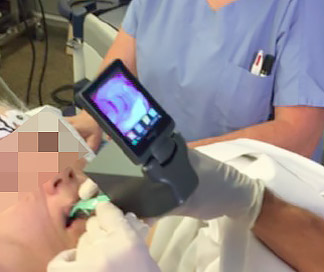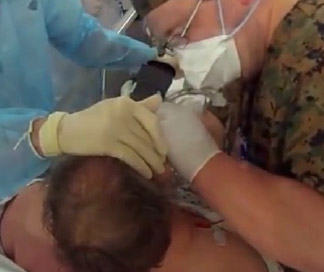Airtraq is more effective for Face to Face intubations
Simulating face-to-face tracheal intubation of a trapped patient: a randomized comparison of the LMA Fastrach, the GlideScope, and the Airtraq laryngoscope
British Journal of Anaesthesia , R. Amathieu, Paris.
Thirty senior emergency medicine physicians were trained in the use of the LMA Fastrach, GlideScope, and Airtraq laryngoscope with a standard airway trainer manikin (control).
Participants were then asked to perform tracheal intubation in two difficult situations simulated on a difficult airway management manikin wearing a cervical collar. In Situation 1, the manikin was in the supine position with a difficult airway caused by stiffening the cervical spine. In Situation 2, the manikin was positioned to simulate face-to-face tracheal intubation. We measured intubation times, success rates for tracheal intubation, and the difficulty of tracheal intubation.
Conclusions. The Airtraq was superior to both the GlideScope and LMA Fastrach during simulated face-to-face difficult tracheal intubation.
Inverse intubation in entrapped trauma casualties: a simulator based, randomised cross-over comparison of direct, indirect and video laryngoscopy
Emerg Med J, Patrick Schober, VU University Medical Center Amsterdam, Holland
Background Airway management in entrapped casualties with restricted access to the head is challenging. If tracheal intubation is required and conventional laryngoscopy is not possible, intubation must be attempted in a face-to-face approach
Methods 24 anaesthesiologists direct laryngoscopy (Macintosh blade #3), Airtraq and McGrath).
The manikin was sitting with the neck immobilised and only accessible from the left anterolateral side.
All three techniques have a high success rate, but the usefulness of the McGrath is limited due to longer intubation duration. Inverse direct laryngoscopy showed reasonable intubation times.
Intubation was always successful and tended to be fastest with the Airtraq device, suggesting that this technique may be a promising alternative

Airtraq Face to Face Intubation

Airtraq Face to Face Intubation

Airtraq Face to Face Intubation
Request a free Airtraq demonstration
Request a FREE on-site demonstration from a local Airtraq Sales Representative.


